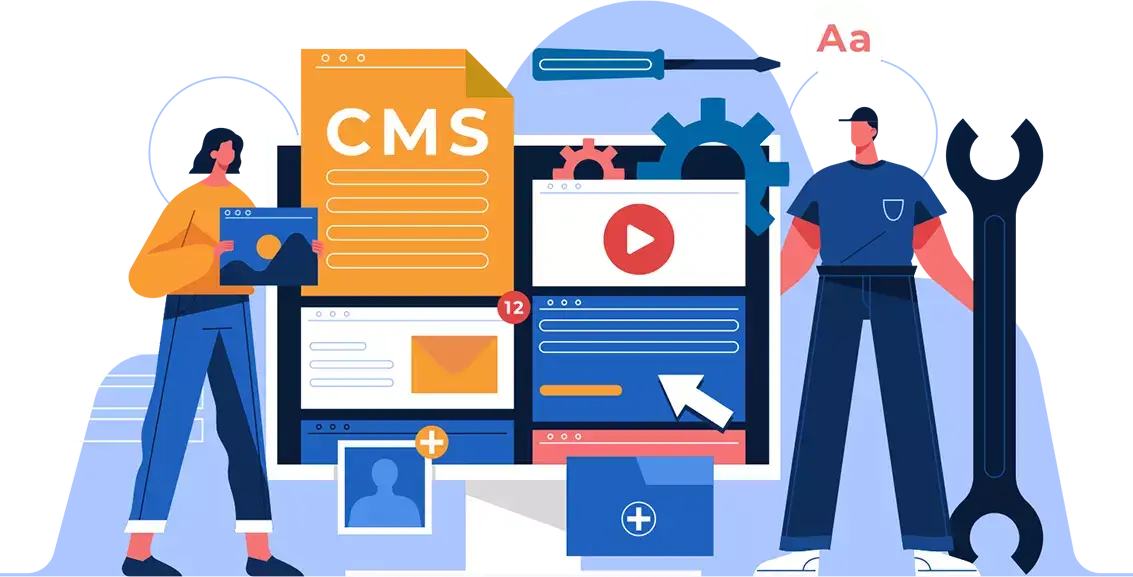WHAT IS A
DIGITAL SIGNAGE SOFTWARE CMS?
USER-FRIENDLY AND RELIABLE CMS
Digital signage software CMS (Content Management System) is a software solution that allows organizations to create, manage, and distribute content to a network of digital displays. The CMS is the backbone of a digital signage network, providing a centralized platform for creating and scheduling content, managing displays, and monitoring performance.

HOW CAN I USE A CMS FOR CONTENT MANAGEMENT?
With a digital signage software CMS, organizations can create and customize multimedia content such as images, videos, text, and the web. In addition, the software provides tools to design, edit, and publish content quickly and efficiently.
A remote content management digital signage software allows organizations to schedule content to play at specific times or dates, set up playlists or loops, and assign content to particular displays or groups of collections.
WHAT ARE THE 6 BENEFITS OF
DIGITAL SIGNAGE CMS SOFTWARE?
MAKE THE MOST OUT OF IT
Digital signage software CMS also provides a range of features for managing and monitoring the performance of the digital signage network.
This includes web based digital signage software, tracking usage data, and monitoring performance metrics such as engagement rates and impressions. The software may also offer analytics tools for evaluating the effectiveness of the digital signage strategy and making data-driven decisions.
Digital signage software CMS (Content Management System) provides several benefits for organizations looking to implement a successful digital signage strategy. Here are some of the key benefits of using digital sign software:
1. CENTRALIZED CONTENT MANAGEMENT
Cloud based digital signage software allows organizations to manage all their digital signage content from a central location. This provides greater efficiency and control over the range displayed on the digital displays.
2. EASY CONTENT CREATION AND CUSTOMIZATION
Organizations can quickly and easily create and customize multimedia content such as images, videos, text, and web content. The software provides tools for designing, editing, and publishing content in a user-friendly interface.
3. FLEXIBLE SCHEDULING
Schedule content to play at specific times or dates, set up playlists or loops, and assign content to particular displays or groups of displays. This provides greater flexibility and control over the content that is displayed.
4. REMOTE MANAGEMENT
Manage displays from a remote location. This saves time and resources and enables quick and efficient updates to the content displayed on the digital signage network.
5. PERFORMANCE MONITORING
Monitoring the performance of the digital signage network. This includes tracking usage data, engagement rates, and other metrics, which can help organizations evaluate the effectiveness of their digital signage strategy and make data-driven decisions.
6. COST-EFFECTIVE
This eliminates the need for expensive hardware and software infrastructure and reduces the cost of managing and maintaining a network of digital displays.

8 STEPS TO SETTING UP YOUR
SIGNAGE CMS SOFTWARE
MAKING IT SIMPLE FOR YOU
Setting up a digital signage software CMS (Content Management System) involves several steps. Here’s a general overview of the process:
1. CHOOSE A DIGITAL SIGNAGE SOFTWARE CMS PROVIDER
Several digital signage software CMS providers are in the market. Choose a provider that meets your organization’s needs and budget.
2. PLAN YOUR CMS DIGITAL SIGNAGE NETWORK
Determine the number of displays, their locations, and the type of content that will be displayed. This will help you choose the proper hardware and software solutions.
3. CHOOSE HARDWARE SOLUTIONS
The hardware solutions that best fit your digital signage network, including displays, media players, and other accessories.
4. INSTALL THE SOFTWARE
Once you have selected a digital signage software CMS provider, install the software on your computer or server. You may need to configure the software settings and connect it to your digital signage network.
5. CREATE CONTENT
Use the digital signage software CMS to create and customize multimedia content such as images, videos, text, and web content. Design and schedule the content to display on your digital signage network.
6. CONNECT DISPLAYS
Connect digital displays to your media players or other hardware solutions. Ensure that they are configured correctly and connected to the internet.
7. PUBLISH CONTENT
Publish the content to your digital signage network. Schedule the range to play at specific times or dates, set up playlists or loops, and assign content to particular displays or groups of displays.
8. MONITOR PERFORMANCE
Use the digital signage software CMS to monitor the performance of your digital signage network. Track usage data, engagement rates, and other metrics, and evaluate the effectiveness of your digital signage strategy.
Setting up a digital signage software CMS requires careful planning, the proper hardware and software solutions, and efficient content creation and scheduling. However, with the right tools and resources, you can implement a successful digital signage strategy that engages and informs your audience.